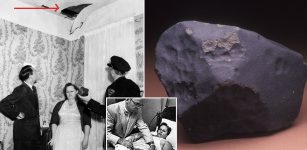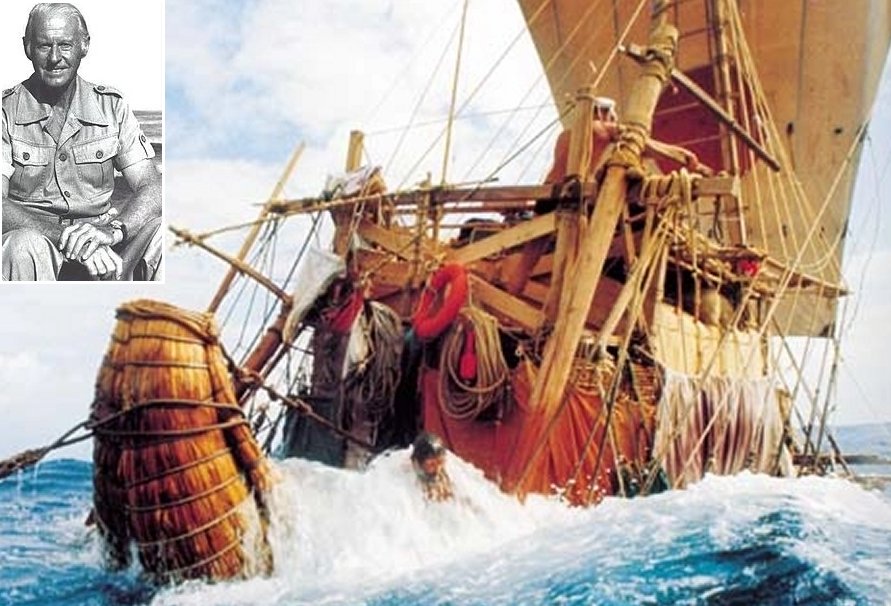On This Day In History: Thor Heyerdahl Sails From Morocco On Papyrus Boat Ra II To Barbados – On May 17, 1970
MessageToEagle.com – On 17th May 1970, the reed boat Ra II with Thor Heyerdahl accompanied by an international crew, set sail from Safi in Morocco on course for Barbados.

With this expedition Thor Heyerdahl (1914 – 2002) wanted to prove that one could have used this type of vessel to cross the Atlantic Ocean in ancient times.
The vessel, Ra II, was built of papyrus by Demetrio, Juan and Jose Limachi from Lake Titicacain Bolivia, and based on drawings and models from Ancient Egypt.
A year earlier, Heyerdahl built a 45-foot-long copy of an ancient Egyptian papyrus vessel with the aid of traditional boat builders from Lake Chad in Central Africa.
Named after the sun god Ra, the boat was transported to Safi in Morocco, from where it set sail for the Caribbean on May 24, 1969. Defects in design and other sailing problems caused it to founder in July, 600 miles short of its goal.
It had sailed 3,000 miles and had almost made it across the Atlantic Ocean.
This time, the expedition was successful.
After a voyage of 57 days and 4,000 miles, the ship arrived in Barbados. The story of this voyage is recorded in the book The Ra Expeditions (1971) and in a documentary film.
Additionally, the expedition took samples of marine pollution and presented their report to the United Nations.
Thor Heyerdahl was a Norwegian adventurer and ethnographer with a background in zoology, botany, and geography. organized and led the famous Kon-Tiki (1947) and Ra (1969–70) transoceanic scientific expeditions. Both expeditions were intended to prove the possibility of ancient transoceanic contacts between distant civilizations and cultures.
For the most part, Heyerdahl’s theories have not been accepted by anthropologists.
Late in 1977 Heyerdahl and an international crew embarked upon the Tigris expedition, a four-month, 4,000-mile voyage in a craft made of reeds.
The expedition began on the Tigris River in Iraq, traveling down the Persian Gulf, across the Arabian Sea to Pakistan, and ending in the Red Sea. The goal of the Tigris expedition was to establish the possibility that the ancient Sumerians might have used similar means to spread their culture through southwest Asia and the Arabian Peninsula.
The voyage was recorded in Heyerdahl’s book The Tigris Expedition (1979) and in a documentary film. He subsequently led research expeditions to the Maldive Islands, to Easter Island, and to an archaeological site in Peru.
The Ra II is now in the Kon-Tiki Museum in Oslo, Norway.
MessageToEagle.com
Related Posts
-
 On This Day In History: Chocolate Was Introduced In Europe – On July 7, 1550
No Comments | Jul 7, 2016
On This Day In History: Chocolate Was Introduced In Europe – On July 7, 1550
No Comments | Jul 7, 2016 -
 On This Day In History: Gold Discovery In The Yukon – On August 16, 1896
No Comments | Aug 16, 2016
On This Day In History: Gold Discovery In The Yukon – On August 16, 1896
No Comments | Aug 16, 2016 -
 On This Day In History: Swedes Under Gustav II Adolph Defeat The Holy Roman Empire During The Thirty Years’ War – On April 15, 1632
No Comments | Apr 15, 2016
On This Day In History: Swedes Under Gustav II Adolph Defeat The Holy Roman Empire During The Thirty Years’ War – On April 15, 1632
No Comments | Apr 15, 2016 -
 On This Day In History: Famous Inventor Thomas Edison Died – On Oct 18, 1931
No Comments | Oct 18, 2016
On This Day In History: Famous Inventor Thomas Edison Died – On Oct 18, 1931
No Comments | Oct 18, 2016 -
 On This Day In History: Hodges Meteorite Crashes Through A Roof And Hits A Woman – On Nov 30, 1954
No Comments | Nov 30, 2016
On This Day In History: Hodges Meteorite Crashes Through A Roof And Hits A Woman – On Nov 30, 1954
No Comments | Nov 30, 2016 -
 On This Day In History: Crew Of Discovery Mutinies Against Captain Henry Hudson – On June 22, 1611
No Comments | Jun 22, 2016
On This Day In History: Crew Of Discovery Mutinies Against Captain Henry Hudson – On June 22, 1611
No Comments | Jun 22, 2016 -
 On This Day In History: Peter The Great Defeats Charles XII Of Sweden At The Battle Of Poltava – On June 28, 1709
No Comments | Jun 28, 2016
On This Day In History: Peter The Great Defeats Charles XII Of Sweden At The Battle Of Poltava – On June 28, 1709
No Comments | Jun 28, 2016 -
 On This Day In History: Parachute Jump From 1,000 m Above Paris Is Recorded – On Oct 22, 1797
No Comments | Oct 22, 2016
On This Day In History: Parachute Jump From 1,000 m Above Paris Is Recorded – On Oct 22, 1797
No Comments | Oct 22, 2016 -
 On This Day In History: Attila the Hun Captures The City of Metz – On Apr 7, 451
No Comments | Apr 7, 2016
On This Day In History: Attila the Hun Captures The City of Metz – On Apr 7, 451
No Comments | Apr 7, 2016 -
 On This Day In History: National Science Day Is Celebrated All Over India – On Feb 28, Every Year
No Comments | Feb 28, 2017
On This Day In History: National Science Day Is Celebrated All Over India – On Feb 28, Every Year
No Comments | Feb 28, 2017


